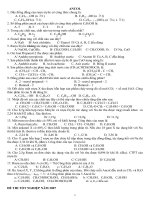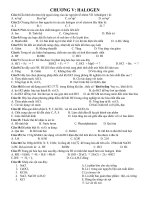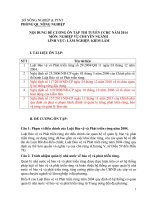Đề cương trắc nghiệm Hành Vi Tổ Chức (Organizational Behavior) CHƯƠNG 13
Bạn đang xem bản rút gọn của tài liệu. Xem và tải ngay bản đầy đủ của tài liệu tại đây (44.36 KB, 14 trang )
Chapter 13: Organizational Conflict and
Negotiation
13-1. The process in which one party perceives that its interests are
being opposed or negatively affected by another party is called
a. mediation.
b. arbitration.
c. conflict.
d. negotiation.
e. task interdependence.
The question was not answered. The correct answer is "c".
13-2. With __________, differences are viewed as personal attacks
rather than attempts to resolve as issue.
a. negotiations
b. socioemotional conflict
c. avoiding style of conflict management
d. task-related conflict
e. both b and d
The question was not answered. The correct answer is "b".
13-3. Intervention that alters the level and form of conflict in ways that
maximize its benefits and minimize its dysfunctional consequences is
referred to as
a. differentiation.
b. procedural fairness.
c. task interdependence.
d. conflict management.
e. arbitration.
The question was not answered. The correct answer is "d".
13-4. All of these are sources of conflict in organizations except
a. task interdependence.
b. ambiguity.
c. goal incompatibility.
d. scarce resources.
e. integration.
The question was not answered. The correct answer is "e".
13-5. As a source of conflict in organizations, __________ occurs when
people hold divergent beliefs and attitudes due to the their unique
backgrounds, experiences, or training.
a. differentiation
b. goal incompatibility
c. ambiguity
d. task interdependence
e. All of these.
The question was not answered. The correct answer is "a".
13-6. The degree to which team members must share common inputs,
interact in the process of executing their work, or receive outcomes
determined partly by their mutual performance refers to
a. differentiation
b. goal incompatibility
c. ambiguity
d. task interdependence
e. All of these.
The question was not answered. The correct answer is "d".
13-7. __________ occurs when the output of one person or unit becomes
the direct input for another person or unit.
a. Sequential interdependence
b. Differentiation
c. Reciprocal interdependence
d. Goal incompatibility
e. Pooled interdependence
The question was not answered. The correct answer is "a".
13-8. Which of these is the highest level of interdependence?
a. Sequential interdependence
b. Differentiation
c. Reciprocal interdependence
d. Goal incompatibility
e. Pooled interdependence
The question was not answered. The correct answer is "c".
13-9. Which of these is trying to find a mutually beneficial solution for
both parties through problem solving?
a. Avoidance
b. Collaboration
c. Compromise
d. Accommodating
e. Competing
The question was not answered. The correct answer is "b".
13-10. An individual high on assertiveness and low on cooperativeness
would probably have which of these conflict management styles?
a. Avoidance
b. Collaboration
c. Compromise
d. Accommodating
e. Competing
The question was not answered. The correct answer is "e".
13-11. Which of these is the only style that represents a purely win-win
orientation?
a. Avoidance
b. Collaboration
c. Compromise
d. Accommodating
e. Competing
The question was not answered. The correct answer is "b".
13-12. People from individualistic cultures tend to use which of these
styles more frequently with co-workers?
a. Avoidance
b. Collaboration
c. Compromise
d. Accommodate
e. None of these.
The question was not answered. The correct answer is "c".
13-13. Common objectives held by conflicting parties that are more
important than their conflicting departmental or individual goals are
called
a. superordinate goals.
b. differentiation.
c. task interdependence.
d. resource negotiations.
e. bargaining zone.
The question was not answered. The correct answer is "a".
13-14. Which of these is not a structural approach to conflict
management?
a. Reduce differentiation
b. Clarify rules and procedures
c. Increase resources
d. Emphasize superordinate goals
e. Mediation
The question was not answered. The correct answer is "e".
13-15. Which of these refers to a structured conflict management
intervention in which the parties discuss their perceptions of each other
and look for ways to improve their relationship by correcting
misinterpretations?
a. Mediation
b. Intergroup mirroring
c. Dialogue
d. Arbitration
e. Superordinate goals
The question was not answered. The correct answer is "b".
13-16. __________ occurs when two or more conflicting parties attempt
to resolve their divergent goals by redefining the terms of their
interdependence.
a. Differentiation
b. Negotiation
c. Task interdependence
d. Bargaining zone
e. Goal incompatibility
The question was not answered. The correct answer is "b".
13-17. All of these are important situational influences on negotiations
except
a. location.
b. time.
c. audience.
d. behavior.
e. physical setting.
The question was not answered. The correct answer is "d".
13-18. Which of these is not a negotiating behavior in resolving
conflict?
a. Gathering information
b. Communicating effectively
c. Audience characteristics
d. Planning and goal setting
e. Making concessions
The question was not answered. The correct answer is "c".
13-19. Which of these is(are) main objective(s) in third party conflict
resolution?
a. Efficiency
b. Outcome fairness
c. Effectiveness
d. Procedural fairness
e. All of these.
The question was not answered. The correct answer is "e".
13-20. The main purpose of which of these third party interventions is to
manage the process and context of interaction between the disputing
parties and not making the final decision about how to resolve the
differences between the parties?
a. Mediation
b. Inquisition
c. Arbitration
d. Intergroup mirroring
e. Compromise
The question was not answered. The correct answer is "a".
TRUE or FALSE
13-1. People experience socioemotional conflict when they view the
conflict experience as something separate from them.
True / False
The question was not answered. The correct answer
is "False". (Coaching responses are only available for answered
questions)
13-2. Effective conflict management involves suppressing task-related
conflict and encouraging socioemotional conflict.
True / False
The question was not answered. The correct answer
is "False". (Coaching responses are only available for answered
questions)
13-3. Conflict that occurs among employees following a merger is
usually caused by different values and beliefs.
True / False
The question was not answered. The correct answer
is "True". (Coaching responses are only available for answered
questions)
13-4. The higher the level of task interdependence, the higher the risk of
conflict.
True / False
The question was not answered. The correct answer
is "True". (Coaching responses are only available for answered
questions)
13-5. The potential for conflict between two employees would be
highest under conditions of reciprocal interdependence.
True / False
The question was not answered. The correct answer
is "True". (Coaching responses are only available for answered
questions)
13-6. With a win-lose orientation, people adopt the belief that the
resources at stake are expandable rather than fixed if the parties work
together to find a creative solution.
True / False
The question was not answered. The correct answer
is "False". (Coaching responses are only available for answered
questions)
13-7. The compromising conflict management style should be used
when both sides trust each other and do not have opposing interests.
True / False
The question was not answered. The correct answer
is "False". (Coaching responses are only available for answered
questions)
13-8. The accommodating style may be appropriate when the other party
has substantially more power or the issue is not as important to you as to
the other party.
True / False
The question was not answered. The correct answer
is "True". (Coaching responses are only available for answered
questions)
13-9. Job and occupational specialization helps to minimize conflict.
True / False
The question was not answered. The correct answer
is "False". (Coaching responses are only available for answered
questions)
13-10. In conflict management, dialogue meetings mainly avoid
dysfunctional conflict by reducing task interdependence.
True / False
The question was not answered. The correct answer
is "False". (Coaching responses are only available for answered
questions)
13-11. The negotiation process moves each party along a continuum
with an area of potential overlap called the opponent's target point.
True / False
The question was not answered. The correct answer
is "False". (Coaching responses are only available for answered
questions)
13-12. Persuasive communication should never be used in negotiations.
True / False
The question was not answered. The correct answer
is "False". (Coaching responses are only available for answered
questions)
13-13. Arbitration, mediation, and inquisition represent the three main
types of third-party intervention.
True / False
The question was not answered. The correct answer
is "True". (Coaching responses are only available for answered
questions)
13-14. Inquisitors have high decision control and low process control..
True / False
The question was not answered. The correct answer
is "False". (Coaching responses are only available for answered
questions)









